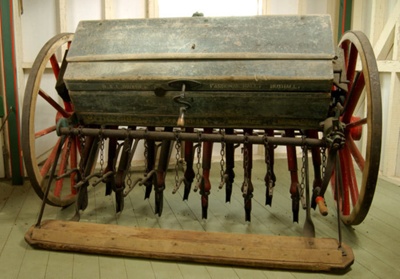Name/TitleSeed Drill
About this objectSmyth Nonpareil Seed drill. It was used by B & L Brooke, Fasbourne Hall Farm, Buxhall, Suffolk in the 1910s. Their seed drills were the first in which the coulters could be adjusted to different widths. The rate of sowing could be adjusted, and it had an improved manure box, fitted with cups, for sowing manure with the grain. The hopper box is blue, while the drills, wheels and frames are red.
Richard Hall, Research Volunteer:
As long as we have grown food, the seed that it grows from, had to be planted or scattered by hand over the land. Over large areas, scattering seed, known as ‘broadcasting’, was very labour intensive and the amount of food actually produced, the ‘yield’, uncertain. Farmers needed a more productive way of sewing a reliable crop.
The earliest simple seed drills were attributed to the Babylonians around 1400 BC, although there is no evidence that this technology ever reached Europe. It is believed that the Chinese, also had multi-tube seed drills as early as the 2nd Century BC. These early seed drills were capable of being pulled over the land by either oxen or later by the horse.
In Europe, early seed drills were used in modern day Italy and their use rapidly spread throughout Europe. In England, the man accredited with inventing the modern seed drill in 1701 was the renowned agriculturalist, Jethro Tull (1674-1741). He saw the benefits of ensuring the correct sowing depth and space were maintained to increase yields.
At the turn of the 19th century, James Smyth (1775-1843) ran a wheelwright business in the village of Peasenhall. James and his brother Jonathan worked together to develop a more effective version of the seed drill mechanism, making use of new cast materials which were becoming increasingly available at the time.
The business was carried on by James and his sons from what was essentially a village workshop but quickly developed into a small factory and thanks to some very effective marketing via local agents; produced six or seven seed drills every week by the end of the 19th century. They exported seed drills all over Europe, Russia and the African continent. James Smyth and Sons were probably one of the very few Suffolk companies at that time who could boast an office in Paris!
The hopper on our seed drill bears the name of both Smyth’s of Peasenhall, the manufacturer and the farm on which the drill was used, stamped on the side. Our punch (STMEA:A.1449) would have been used to create part of the wording on the hopper.
MakerJames Smyth & Sons Ltd.
Date MadeCirca 1911
Place MadePeasenhall, Suffolk
Medium and MaterialsMechanism, drills and wheel run: Metal
Wheels, box and frame: Wood
Inscription and MarksStencilled on hopper box: B&L Brooke, Fasbourne Hall, Buxhall (white paint)
Stencilled on hopper box: Smyth & Sons Ltd Peasenhall Suffolk No.28179
Moulded on both sides: 'Smyths' Patent Nonpareil
Measurementsheight: 1350mm
length: 1970mm
width: 1600mm
Object Typedrill
Object numberSTMEA:1984-35.1
Copyright Licence![]() Attribution - Non-commercial (cc)
Attribution - Non-commercial (cc)



